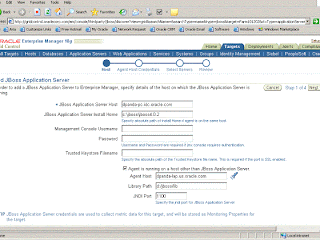Although I would like that you use Oracle Application Server always I realize that heterogeneous platforms are reality today :) You may have JBoss application server in your environment and you may want to monitor that from Grid Control. Oracle provides a management plug-in for Grid Control to monitor health and performance of JBoss Application Server.
In this blog entry, I will outline the steps to discover JBoss Application Server from Grid Control.
Let us assume that you have installed JBoss Application Server in a server named dpanda-pc in c:\jboss\jboss4.0.2 directory (call it JBoss_Home), your agent is running on a remote host named dpanda-lap.
1. Login to Grid Control 10g R4
2. Click on Application Servers Menu item
3. Select Add -> JBoss Application Server and click on GO
4. Enter name of the server where JBoss is running as Application Server Host
5. Enter the JBoss Home -> the top level directory where JBoss is installed. Note this is not required if you are using Agent installed on a separate host.
6. You have to supply userid/password only if you have enabled security for JMX Console. See
http://wiki.jboss.org/wiki/Wiki.jsp?page=SecureTheJmxConsole how you can make JBoss Console secured. This credential will be used by Agent to make JMX connection to gather health/statistics.
7. You can use a remote Intelligent Agent to discover JBoss. If so you have to appropriately select the check box as depicted in the following figure figure:

The Agent requires the JBoss JMX client jar files to make JMX connection to JMS.
Hence you have to copy the following files to a directory e.g. c:\jboss\lib and make it available to the Agent as Library Path:
- jboss-management.jar from JBoss_Home/server//lib
- jnp-client.jar from JBoss_Home/client
- jbossall-client.jar from JBoss_Home/client
- dom4j.jar from JBoss_Home/lib
Note: Make sure that you restart IA otherwise the current status of JBoss Servers will not be reported correctly post discovery.8. You have to supply the JNDI port for JBoss server and click next
9. Then you have to supply the credentials for the server/host where JBoss is running
10. It will provide a list of the JBoss partitions and/or Servers that it found in the host and you can select the servers that you want to manage and then click Next
After you confirm at the end of wizard , the JBoss servers will be discovered and you can monitor JBoss Application Server from Grid Control.
